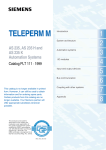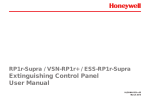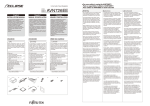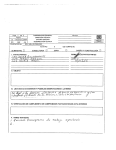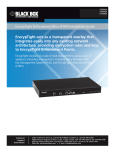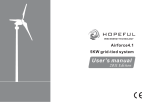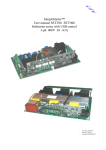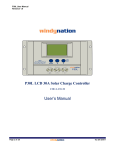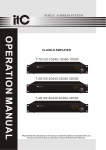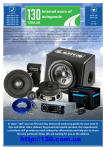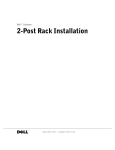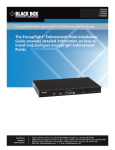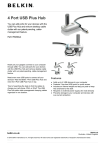Download IP20 3U Power System Installation Manual
Transcript
Installation Manual For IP20 3U Power System ISSUE A ECO # DATE 25.Oct. 2011 CO# 10078396 SECTION REVISIONS DESCRIPTION APPROVED BOM RELEASE Hubert Ulm NSN IP20 3U Power System PREPARED/DATE: Andy Brown / 15-07-2011 CHECKED/DATE: MODEL NO.:7001590-J000 2 IP20 3U Power System Installation Manual Emerson Network Power Co., Ltd. http://www. emersonnetworkpower.com.cn Flexi Power Rectifier Installation Manual Installation Manual Manual Number: 9702526-0000 Rev. A Manual Status: Standard Release Date: 25.October 2011 Copyright © 2011 Emerson Network Power Co., Ltd. All rights reserved Published in Austria This document, and the information it contains, are the property of Emerson Network Power Co., Ltd, and are protected by law. Both must be held in strictest confidence at all times. Emerson Network Power grants no license or right to copy, use or disclose either, expressly or by implication. Disclaimer This document and the information contained herein are provided on an "AS IS" basis. Emerson Network Power may make improvements or changes in this documentation, at any time and without notice and as it sees fit. The information in this documentation was prepared by Emerson Network Power with reasonable care and is believed to be accurate. However, Emerson Network Power shall not assume responsibility for losses or damages resulting from any omissions, inaccuracies, or errors contained herein. Flexi Power Rectifier Installation Manual History 4 History Date Version Author Change Note No./Notes 18/05/2010 01 Andy Brown First release 15/07/2011 02 Andy Brown Second release 11/08/2011 03 Markus Grünwald Add customer feedback 18/10/2011 A Daniel Kreuzer Changed PSA Alarm Table IP20 3U Power System Installation Manual Table of contents 5 Table of contents History ........................................................................................................ 4 Table of contents........................................................................................ 5 List of figures .............................................................................................. 7 List of tables ............................................................................................... 9 List of terms.............................................................................................. 10 Preface ..................................................................................................... 11 Quick reference step guide ...................................................................... 13 Step description ........................................................................................ 13 Chapter 1 Product Introduction .............................................................. 14 1.1 General Description ............................................................................... 14 1.2 Specification .......................................................................................... 14 1.3 Properties .............................................................................................. 18 1.4 The Power Sub-rack Assembly (PSA) ................................................... 21 1.5 The Rectifier .......................................................................................... 25 1.6 The System control unit (SCU) .............................................................. 28 1.7 The additional Low voltage disconnect unit LVDU ................................ 29 1.8 The optional Surge Suppression Unit .................................................... 30 Chapter 2 Preparation ............................................................................ 31 2.1 Safety Summary .................................................................................... 31 2.2 Installation site ....................................................................................... 33 2.3 Installation tools and test equipments.................................................... 33 2.4 Check list of the IP20 3U Power System ............................................... 34 Chapter 3 Hardware Installation ............................................................. 39 3.1 Remove the unit from the packaging ..................................................... 40 3.2 Remove the lid from the system ............................................................ 41 3.3 Configure the terminal blocks ................................................................ 44 3.3.1 Configure the AC terminal blocks .......................................................... 44 3.3.2 Configure the DC terminal blocks and breakers .................................... 49 Installing the system modules .................................................................. 54 4.1 Installation of the rectifiers ..................................................................... 54 4.2 Removal of the SCU .............................................................................. 59 4.3 Installation of the SCU ........................................................................... 62 4.4 Installation of the additional Load and LVD unit .................................... 63 4.5 Installation of the surge protection device ............................................. 67 Connect the cables .................................................................................. 69 5.1 Connect the AC cables .......................................................................... 70 5.1.1 Earth connection - Connect the AC Earth cable .................................... 71 5.1.2 Earth connection - Connect the system earth ........................................ 72 IP20 3U Power System Installation Manual Table of contents 6 5.1.3 Earth connection – Output earth link ..................................................... 73 5.1.4 Connect the AC Live cable(s) ................................................................ 74 5.2 Connect the DC LOAD cables ............................................................... 76 5.2.1 Connect the DC LOAD-1 cables ............................................................ 76 5.2.2 Connect the DC LOAD-2 cables ............................................................ 77 5.3 Connect the DC Battery cables ............................................................. 78 Final system Assembly ............................................................................ 79 6.1 Cable management ............................................................................... 79 The final system assembly ....................................................................... 80 IP20 3U Power System Installation Manual List of figures 7 List of figures Figure 1 Figure 2 Figure 3 Figure 4 Figure 5 Figure 6 Figure 7 Figure 8 Figure 9 Figure 10 Figure 11 Figure 12 Figure 13 Figure 14 Figure 15 Figure 16 Figure 17 Figure 18 Figure 19 Figure 20 Figure 21 Figure 22 Figure 23 Figure 24 Figure 25 Figure 26 Figure 27 Figure 28 Figure 29 Figure 30 Figure 31 Figure 32 Figure 33 Figure 34 Figure 35 Figure 36 Figure 37 Figure 38 Figure 39 Output power-derating characteristic The schematic of the IP20 3U Power System General view of the IP20 3U Power System Rear view of the IP20 The PSA sub-rack The PSA sub-rack without the casing lid Identifying the system components The IP20 rectifier The rectifier communication cable The SCU unit The optional LVD unit that can be fitted to the PSA The Surge suppression unit that can be fitted to the PSA Product tree The PSA when delivered before the installation Cutting the cable ties that secure the AC cables The screw positions on the PSA Lifting and removing the lid of the system The location of the electrical terminations within the chassis The AC cable connection chart Schematic diag of AC connection without the SPD 1Φ AC terminal block configuration – 1Φ Schematic diagram of AC connection without the SPD – 3∆ AC terminal block configuration – 3∆ Schematic diag of AC connection without the SPD 3Y AC terminal block configuration – 3Yconnection Breaker switch linking bar Standard DC connections NO linking bar’s or bridges in place Adding the bridging component to the load circuit breakers Adding the switch linking to the load circuit breakers Breaker bridge component in place and switch links fitted Fitting CB3/CB4 breaker switch linking bar System ready to accept the rectifier units Putting the rectifier into the first slot of the chassis DC connections of the rectifier The first rectifier fully engaged with the system The system fully populated with rectifiers AC cables connected to the rectifiers in the rack AC cables and signal cables connected to the rectifiers in the rack Placing the temperature probe IP20 3U Power System Installation Manual List of figures 8 Figure 40 Figure 41 Figure 42 Figure 43 Figure 44 Figure 45 Figure 46 Figure 47 Figure 48 Figure 49 Figure 50 Figure 51 Figure 52 Figure 53 Figure 54 Figure 55 Figure 56 Figure 57 Figure 58 Figure 59 Figure 60 Figure 61 Figure 62 Figure 63 Figure 64 Figure 65 Figure 66 Loosening the SCU mounting screws SCU withdrawn from the system chassis Removal of the SCU connectors Releasing the Alarm signal connector SCU rear panel detail Removal of the Load-2 blank panel Placement of the Load 2 LVD/Load module into the system Correct mechanical placement of the Load 2 LVD/Load unit Tighten the LVD M6 nut electrical connection Cable tie the LVD signal wires to the top of the SCU slot Fitting the Load-2 Load/LVD signal connector to the SCU Fitting the SPD to the DIN rail in the PSA. Wiring the SPD into the AC connections The SPD signal connections and wiring loom The SPD signal connector at the SCU Connecting the AC system earth cable Position of the protective earth bonding stud Position of the 0V dc bus ground connection AC cable connection to the system Load-1 DC cable connection to the system Load-2 DC cable connection to the system Battery DC cable connection to the system Cable tie position Cable exit from the system Refitting the cover to the system The finally assembled system ready for system integration The finally assembled system ready for system integration IP20 3U Power System Installation Manual List of tables 9 List of tables Table 1 – Contents of this manual ...................................................................... 11 Table 2 – Symbols in the Installation Manual ...................................................... 12 Table 3 – Reference documents of the IP20 ....................................................... 12 Table 4 – Main specifications of the IP20 3U Power System .............................. 14 Table 5 – Applicable rated input voltage types of the IP20 3U Power System.... 15 Table 6 – Main voltages and the corresponding EAC alarms ............................. 16 Table 7 – Static data of the DC output ................................................................ 17 Table 8 – PSA alarm settings ............................................................................ 23 Table 9 – LEDS on the PDA front panel ............................................................. 24 Table 10 – LEDS on the rectifier front panel ....................................................... 26 Table 11 – Term and Symbols in this manual ..................................................... 32 Table 12 – Symbols on the IP20 ......................................................................... 32 Table 13 – Delivery contents by IP20 3U Power System .................................... 35 Table 14 – Three typical battery / load cables configurations ............................. 53 IP20 3U Power System Installation Manual List of terms 10 List of terms A AC AWG BAT BR BTS Ampere Alternative current American Wire Gauge Battery Battery Return Base Transceiver Station MCB CSA CU DC EMC ESD FPRA GND GUI IE IP IP L Micro Circuit Breaker Cross Section Area Control unit Direct current Electromagnetic Compatibility Electrostatic Discharge Flexi Power Rectifier Ground Graphical User Interface Internet Explorer Ingress Protection Internet Protocol Live cable from the AC mains IP20 3U Power System LAN LCD LED LVD MAC N N/A PC PCB PSA PE PSU RTN SPD V VPN 1Φ 3Y 3∆ Local Area Network Liquid Crystal Display Light Emitting Diode Low Voltage Detection Media Access Control Neutral cable from the AC mains Not applicable Personal Computer Printed Circuit Board Power Sub-rack Assembly Protective earth Power Supply Unit Return Surge Protect Discharge Volt Virtual Private Network Single-phase AC type 3-phase star AC type 3-phase Delta AC type Installation Manual List of terms 11 Preface About this manual This manual guides the user on how to install the IP20 3U Power System including the hardware installation, the browser and CU setup. The manual also introduces the System as well as its commissioning, maintenance and troubleshooting. The contents of this manual are listed in Table 1. Table 1 – Contents of this manual Chapter Title Content 1 Product instruction Describes the specifications, properties, mechanical data, etc. of the IP20 and the modules it contains. 2 Preparation Describes the installation safety, site, and tools. 3 Hardware installation Describes how to install the AC cables, DC cables, communication cables, parallel installation, etc. of the IP20. 4 Browser and CU setup Describes how to set the browser and CU, and access the GUI. 5 Commissioning Describes how to commission the IP20 after the installation. 6 Maintenance Describes how to maintain the IP20. 7 Troubleshooting Describes how to solve the detected issues of the IP20. IP20 3U Power System Installation Manual List of terms 12 Term and Symbols in this manual These term and symbols in Table 2 might appear in the manual: Table 2 – Symbols in the Installation Manual Symbol Description Safety symbol, see Safety summary Safety symbol, see Safety summary Provides hints to the user for easier installation, maintenance and troubleshooting The necessary supplementary of the article to let user be clearer. Reference documents The documents of the IP20 3U Power System contain: Table 3 – Reference documents of the IP20 Document User manual IP20 3U Power System Emerson Network Power File No. User Manual FPRA IP20 100 Installation Manual List of terms 13 Quick reference step guide Step description 1 - Unpack. Unpack the system Make sure all system components are present Cut the AC cables free from the chassis and remove and discard the cable ties 2 - Configure terminations. Open the lid of the subrack casing Configure the AC terminal blocks depending on the AC supply network. Configure the DC terminal blocks with bridging component and switch linking bar as appropriate for the deployment required, Configure the Battery terminal blocks with bridging component and switch linking bar as appropriate for the deployment required, 3 - Install modules Install the rectifiers and secure with the mounting screws Install and connect the addition LVD/Load module if required. Install and connect the SCU if required Connect the AC cables to the rectifiers Connect the communication cables from the SCU to the rectifiers 4 - - Connect to the system Make sure the AC cables are NOT powered. Connect the AC earth connection to the system Connect the AC live cable to the system ‘Live’ termination at the Dinrail mounted terminal block inside the system Connect the AC Neutral cable to the system ‘Neutral’ termination at the Din-rail mounted terminal block inside the system Connect the –48Vdc DC load cables to the Load breaker terminals inside the system Connect the 0VDC load cables to the 0V bus bar inside the system. Connect the Battery cables to the battery breaker terminals inside the system Connect the 0VDC battery cables to the 0V bus bar inside the system 5 REPLACE THE SYSTEM COVER. 6 - Power up the system Connect the AC power to the system - IP20 3U Power System Installation Manual Product Introduction 14 Chapter 1 Product Introduction 1.1 General Description The IP20 3U Power System is a 6kW output power AC rectifier package made up of three individual 2kW AC/DC power modules operating in a parallel mode configuration. The IP20 outputs a positive earthed –54VDC (V48N) as a respective BTS operational supply voltage rail and for site battery charging. It also includes a Power Distribution Assembly (PDA), which has a fully integrated battery protection LVD, load / battery circuit breakers, battery current shunt and alarm signals to the BTS EAC interface. The product is intended for use on the following power systems: IT, TN, TT 1.2 Specification • Main specifications Table 4 – Main specifications of the IP20 3U Power System Parameter Specification Description Min Nom Max Rated AC input voltage (VAC) 180 -- 276 See Table 5 DC Nominal Vout (VDC) -56 -54 -52 See Table 7 Iout (ADC) 0 -- 109.9 See Table 7 Operation -10 23 55 (1) Max output 6kW Storage -45 -- +45 Start up -10 -- -- Output Ambient temperature (°C) Max output 6kW Note: (1) The power supply unit is fully compliant with the operational and power output requirements outlined within the Product Specification at the maximum ambient temperature 55°C IP20 3U Power System Installation Manual Product Introduction 15 • AC input The rated input voltage of the IP20 is 180~276VAC (200~230 VAC – 10%/+20%). The rectifiers can be connected as single-phase 230 VAC inputs or as 400 VAC (phase to phase) 3-phase Star or as 200 VAC (phase to phase) 3-phase Delta. The IP20 is to be operated when connected to a fuse or means of external protection e.g. Circuit Breaker or Fuse with a maximum current rating of 50A, min 240V shall be provided in the branch circuit. Table 5 shows the various rated inputs that the IP20 are applicable and allowed for. Table 5 – Applicable rated input voltage types of the IP20 3U Power System VAC / V (Nominal) VAC / V (Range) Frequency / Hz Supply Network Type 240 180 – 276 45 – 66 US Single phase; threewire; earthed mid point of phase 230 180 – 276 45 – 66 Europe Single Phase 208 Phase to Neutral 180 – 276 45 – 66 US 3-phase star; four wire; earthed neutral 240 Phase to Phase 180 – 276 45 – 66 US 3-phase delta; fourwire; earthed mid point of phase 202 Phase to Phase 180 – 276 45 – 66 Japanese 3-phase delta 230 Phase to Neutral 180 – 276 45 – 66 European 3-phase star; four wire; earthed neutral) The IP20 is designed to operate with extended operation input main voltage, at the low range between 150 ~180 VAC (with derated output power, see Figure 1) and at upper range between 276~310 VAC. The IP20 accepts, without damage, single phase AC input voltage of up to 350VAC at frequency of 45~66Hz, for a duration of up to 60s. IP20 3U Power System Installation Manual Product Introduction 16 Table 6 – Main voltages and the corresponding EAC alarms VAC / V Status EAC alarm <150 Low mains voltage – Rectifier shutdown Yes (2) 150 ~ 180 (-5) (1) Operational – extended and low mains voltage range Yes Minor (3) 180 ~ 276 Rated operation No (2) Refer to Table 5 277 (+5) ~ 310 Operational – extended and high mains voltage range Yes Minor (3) >315 (±5) Over mains voltage– Rectifier Shutdown Yes Major (3) Mains phase failure (3) #1 / #2 / #3 Note: (1) Here indicates the 180 VAC has a –5 VAC tolerance. (2) “Yes” / ”No” means the PDA sends /not sends the EAC alarm. The illustration is available for all same expressions in this table. (3) Refer to Table 8 for the detailed EAC alarms. Figure 1 – Output power-derating characteristic Note: N+1 (failure) defines the condition that one of the three rectifiers has failures, and only two rectifiers operate normally to support the load. • DC output The –54VDC output, here referred to as V48N, is with respects to V48RTN (positive) which is grounded within the IP20. See Table 7 for more details about the DC output. IP20 3U Power System Installation Manual Product Introduction 17 Table 7 – Static data of the DC output Parameter Output Voltage (VDC) Spec Description -54± 2(1) Nominal output voltage -57~-45 Output voltage range Factory Output Voltage set point (VDC) -53.3±0.6 Factory default setting at +27°C Line regulation <1% For a load from Minimum to Maximum at +27°C Minimum Hold Up (ms) 20 For a load from Minimum to Maximum Current Limit (ADC) +10% @ Maximum output 6kW OVP Limit (VDC) 58.5 ±1.0 Factory set Output Low Voltage Alarm (VDC) 40±0.5 Ripple & noise (mV) 300 6 Max Output power (kW) 6 ~ 4.5 Minimum Output power (kW) -- Efficiency >90% Factory set Max output 6kW, -10~+55°C -10°C ~+55°C 6kW derating to 4.5kW @ +55°C → 65°C No minimum load limitation Nominal AC input range, Max output 6kW Note: (1). The values in the table shall be met for all input voltages and frequencies within the rated and extended input ranges, and all valid output load conditions. IP20 3U Power System Installation Manual Product Introduction 18 1.3 Properties The IP20 3U Power System has the following properties: • High-integrated power system. The IP20 integrates the rectifiers, the AC and DC distribution, and supervisor and communication functions. • Modularized design. The modularized design of the IP20 leads to easier installation, maintenance and troubleshooting. • Flexible applications. The IP20 supplies the user with a varied output power of 2/4/6kW by means of installing 1/2/3 rectifier modules. Also the 4 battery back-up channels and 2 load channels of the IP20 provides the user with flexible battery and load applications. • Variable AC power connections. The IP20 can be used with different AC power types mentioned in Table 5 by means of reconfiguring the internal AC terminal block. • Easy to control. The user can control and supervise the operation of the IP20 via the GUI after connecting the IP20 to a user PC. The IP20 comprises of one System chassis and between one to three identical 2kW rectifiers working in a parallel mode. The schematic diagram of the IP20 3U Power System is as shown in the following figure. IP20 3U Power System Installation Manual Product Introduction 19 IP20 3U Power System Installation Manual Product Introduction 20 This presents the general view of the IP20 3U Power System with all of the cables connected to each of the system modules and the addition load connection unit fitted to the subrack. Figure 3 General view of the IP20 3U Power System The figure below shows the back view of the IP20 after installing all the rectifiers but without load cables fitted. Figure 4 Rear view of the IP20 IP20 3U Power System Installation Manual Product Introduction 21 1.4 The Power Sub-rack Assembly (PSA) The PSA is the system enclosure for all system modules and is the point of connection to and from the power system. The front face of the PSA is where the following items are located - The slots for the rectifiers - The breakers for the load connections - The breakers for the battery connections - The AC cables for the rectifiers - The communication ports for the rectifiers and the system - The PSA Display - Alarm LED’s. Note that all connections from the PSA are made by removing the cover and exposing the respective terminals. Figure 5 The PSA subrack IP20 3U Power System Installation Manual Product Introduction 22 When the system lid is removed, all of the following connection points are revealed; - Load connection point - Battery connection point - Ground connection points - Cable routing management points - AC connection points Figure 6 The PSA subrack without the casing lid SCU -48Vdc Load terminal Rectifier AC cables -48Vdc battery terminal LVD unit AC Termination block DC ground connections Figure 7 Identifying the system components IP20 3U Power System Temperature probe Installation Manual Product Introduction 23 Table 8 – PSA alarm settings EAC alarm Description Alarm 1 Enables the Signal on Alarm Pin 1 Alarm 2 Enables the Signal on Alarm Pin 2 Alarm 3 Enables the Signal on Alarm Pin 3 Alarm 4 Enables the Signal on Alarm Pin 4 Alarm 5 Enables the Signal on Alarm Pin 5 Alarm 6 Enables the Signal on Alarm Pin 6 • Network connection based on LAN. The PDA can be connected to a user PC via the internal RJ45 interface. The user can monitor the whole system via a web-based GUI. Each possible Alarm of the System (including Control Unit and Rectifier) can be mapped to one of the Alarm Out Pins on the backside of the Control Unit. Multiple Alarms can be mapped to a single pin. Combinations of alarms can be mapped to a single pin. For a “how to change” the mapping of the alarms please put a reference to the User Manual (section tbd) IP20 3U Power System Installation Manual Product Introduction 24 The LEDS on the PSA front panel will have any of the status listed in Table 9. Table 9 – LEDS on the PDA front panel LED Mark Status GREEN LED ON • Unit is in operational mode ON • Dependant on User Settings: All SCU Alarms, which are set to severity ‘Minor’ or ‘Warning’ will turn ON the yellow LED FAULT LED ON • Dependant on User Settings: All SCU Alarms, which are set to severity ‘Critical’ or ‘Major’ will turn ON the red LED All LEDS Turn on simultaneously and turn off after about 2 seconds System initialization YELLOW LED IP20 3U Power System Indication Installation Manual Product Introduction 25 1.5 The Rectifier The IP20 supports the operation of up to three rectifiers in parallel. Each rectifier is an AC/DC module, which meets the specifications listed in Table 5 and Table 7. The rectifier has the following properties: • High efficiency. The rectifier has an over 90% efficiency at the nominal AC input voltage. • Over current protection. The rectifier shuts down once an over current is detected, and recovers automatically when the fault is no longer present. • Over voltage protection. The rectifier shuts down once an over voltage is detected for the first time, and recovers automatically when the fault is no longer present. If the over voltage is detected for the second time, the rectifier will shuts down for ever until the AC power supply re-powers up to restart the rectifier. • Monitoring function. The rectifier monitors different parameters such as input voltage, output voltage, etc., and sends out a corresponding alarm signal in case it detects a fault. • Self-cooling function. Each rectifier has an internal fan for cooling. • RS485 interface. The rectifier can be connected to the PDA via the internal RS485 interface. In this way, user can monitor and control three rectifiers via the GUI. The general view of the rectifier is as shown in figure 6. Status LEDs Communication port Mounting screws AC cable connector Figure 8 The IP20 rectifier IP20 3U Power System Installation Manual Product Introduction 26 There are 3 status LED’s on the front of the PSU to indicate its operational status. Green, Yellow and Red If the yellow LED or the red LED is ON the specific bits in the status register (PSU_STATUS) indicate the origin of the fault or warning When the red LED is ON also a “General HW error” is reported on the communication bus (Status register, bit 0). The “General HW error” can only be cleared by a “Power On Reset” of the microcontroller. If the failure still exists the red LED and the flag will appear again. Table 10 lists the LED indications of the rectifier. Table 10 – LEDS on the rectifier front panel LED Mark GREEN LED YELLOW LED RED LED Status Indication The unit is in operational mode and RS485 communication is active; if no other LED is active full functionality is Normal provided; operation when the green LED is blinking the unit provides output power but RS485 communication is not active is ON in case of following conditions: • AC input under voltage (status register, bit 1) • AC input over voltage (status Warning register, bit 8) condition • Temperature shutdown (status register, bit 5) • DC output short circuit (not reported on RS485 bus) will be activated in case of: • a broken fuse (not in status register) Fault • a fan fault (status register, bit 9) condition • a broken O-ring Mosfet – DC output (not in status register) IP20 3U Power System Installation Manual Product Introduction 27 Note that the rectifier will be supplied with a communication cable so that it can be connected to the system. This cable is shown in the following figure Figure 9 The rectifier communication cable IP20 3U Power System Installation Manual Product Introduction 28 1.6 The System control unit (SCU) The power system is monitored and controlled by the SCU unit. This unit performs all of the following functions - Communications with the rectifiers Communications from the PSA to the host system Displays the current status Displays the alarm and system status. Note that this unit will be supplied already fitted within the PSA and should not be removed unless one of the additional system modules (Load-2 load/LVD or Surge protection device) is to be fitted to the system chassis. The alarm configuration to the O/P signals and how to re-configure those alarms is described in the User Manual. LED Status indicators Rectifier communication ports LCD message screen Control buttons Mounting screws Figure 10 The SCU unit IP20 3U Power System Installation Manual Product Introduction 29 . 1.7 The additional Low voltage disconnect unit LVDU There is an additional unit that can be fitted to the subrack that extends its capability by adding 2 additional load breakers and LVD circuitry to the system. This unit is supplied separately and must be installed correctly if required by the deployment required according to the instructions contained in this document. Figure 11 The optional LVD unit that can be fitted to the PSA. IP20 3U Power System Installation Manual Product Introduction 30 1.8 The optional Surge Suppression Unit There is an additional surge suppression unit that can be fitted to the subrack which extends the systems surge immunity capability. This is required where the mains AC feed is particularly un-predictable and has transients on it. This unit is supplied separately and must be installed correctly if required by the deployment required according to the instructions contained in this document. Figure 12 The Surge suppression unit that can be fitted to the PSA. IP20 3U Power System Installation Manual Preparation 31 Chapter 2 Preparation 2.1 Safety Summary 2.1.1 Injury and product damage precautions The following precautions must be observed during all phases of servicing the product, such as installation, maintenance or configuration. Any omission of the precautions might cause injury and/or product damage. • Do not service the product during a thunder / lightning storm to avoid electric shock. • Turn off the AC power source when accessing the AC cables or the SPD to avoid electric shock. • Make sure the product is well grounded before servicing the product to avoid electric shock. • Do not install the product in an explosive atmosphere to avoid injury or fire hazard. • Do not service the product if the environment cannot meet the requirements defined in the product specification. • Do not place the product in an unstable rack, to avoid the product damage in case of a fall. • Do not open the restricted area by unqualified personnel, to avoid damage to the product. • After unpacking, do not start the installation if you suspect any product damage caused by shipment. • Pay attention to the specific warning/caution terms and symbols in this manual. • Equipment is intended for installation in restricted access locations • Requirements for protection in service access areas and restricted access areas apply • Equipment is intended for operation at altitudes up to 3000m above sea level 2.1.2 Safety Term and Symbols These term and symbols listed in Table 11 may appear in this manual: IP20 3U Power System Installation Manual Preparation 32 Table 11 – Term and Symbols in this manual Term & Symbol Description Warning statement identifies conditions or practices that could result in bodily injury or loss of life. It warns the reader to be extremely careful. Caution statement identifies conditions or practices that could result in damage to this product or devices connect to it. It indicates that the reader must be careful. The symbols listed in Table 12 may appear on the IP20 3U Power System: Table 12 – Symbols on the IP20 Symbol Description Risk of electric shock: To avoid electric shock, user shall not touch the product. DC Voltage Hazard: There is DC voltage at the indicated position. Hot surface: To avoid being burnt, user shall not touch the product when it is in operation. ESD caution: Means user should wear a well-grounded ESD wrist strap to avoid product damage. Protective earth terminal: Connect the protective earth cable in the indicated position. System earth terminal: Connect the system earth cable in the indicated position. Recycle: User cannot dispose of this electronic product in the trash. To protect the environment, please recycle. IP20 3U Power System Installation Manual Preparation 33 2.2 Installation site To ensure normal operation and long service life of the product, install it in an environment that meets the following requirements: • Temperature The IP20 should be used and maintained in the temperature that defined in Table 4. • Cleanness Dust is a hazard to the operation to the device. The dust accumulated on the chassis can be absorbed by static electricity and result in poor contact of metal connectors. This not only shortens the service life of your device but may also cause communication failures. Besides dust, the harmful gases, containing salts, acids and sulfides, can accelerate the corrosion and aging of metals. • Ventilation Each rectifier has an integrated fan for cooling. The airflow is from the rear to the front of the rectifier unit. Consideration should be given to the amount of clearance necessary to ensure IP20 cooling when configured within cabinets. 2.3 Installation tools and test equipments Tool kit: ESD wrist strap and cable TORX screwdriver set: T10, Flat screwdriver Cross screwdriver (6xP1 Phillips) Nut spinner for M6 and M5 nut Side cutters Lint-free swab or wipe and 99% alcohol for cleaning optical connectors Cable ties for routing cables Flashlight, pocket lamp or torch Pliers Wire-stripper • Test equipments PC (optional) Multi-meter: FLUKE 170 or equivalent DC Current clamp: FLUKE I410 or equivalent IP20 3U Power System Installation Manual Preparation 34 2.4 Check list of the IP20 3U Power System The figure below shows the product configuration and modules that can be used in the IP20 system Customer configuration IP20 3U Power system 7001590-J000 IP20 SCU unit 7001588-J000 IP20 Rectifier chassis 7001589-J000 IP20 Surge protection device SPD Kit 7001597-J000 Additional optional units that can be fitted to IP20 IP20 Rectifier 48/2000 7001587-J000 IP20 Low voltage disconnect LVLD Kit 7001596-J000 Figure 13 Product tree Table 13 lists the delivery contents by IP20. ¾ One IP20 may adopt one or two or three rectifiers to meet the user’s requirement. ¾ The Surge Protection Unit is optional for the user, and is supplied independently of the IP20 ¾ The part number listed in Table 13 is based on the present materials used, and Emerson may change some materials and corresponding part numbers in future. Therefore the user should contact Emerson for updated information in time. IP20 3U Power System Installation Manual Preparation 35 Table 13 – Delivery contents by IP20 3U Power System Name Figure Description Usage Emerson Module Part Number PSA SCU The case of the IP20 3U rectifier chassis, in which the SCU and rectifiers are installed. 1 The system control unit 7001589-J000 7001588-J000 1 IP20 3U Rectifier chassis Phoenix 3-pole Bridge Phoenix 2-pole Bridge IP20 3U Power System Used to configure the AC terminal block 2 7001590-J000 4521590-0000 Used to configure the AC terminal block 3 Installation Manual 4521731-0000 Preparation 36 DC breaker bridge Component to bridge 2 breaker terminals 3 5002916-0000 Breaker switch link Component to link 2 breaker switches together. 3 5003081-0000 Cable tie Used to tie the cables 25 NA65300-- Rectifier The AC/DC rectifier module 1 7001587-J000 Rectifier 48/2000 Rectifier communication cable The cable to connect the rectifier to the SCU. 1 4380189-0000 The additional LVD unit The additional LVD unt 1 7001596-J000 7001587-J000 LVLD kit 7001596-J000 M6 nut IP20 3U Power System Connection component for DC power connections 1 Installation Manual 6010279-0000 Preparation 37 M6 Washer For use with the M6 nut above. 1 6010018 M3 Torx screw Screw for mechanically assembling the additional Load module to the chassis 4 SCR-023001 DC breaker bridge Component to bridge 2 breaker terminals 1 5002916-0000 Breaker switch link Component to link 2 breaker switches together. 1 5003081-0000 Cable tie Used to tie the cables 5 NA65300-- SPD Surge Protection Discharge 1 including cables 7001597-J000 SPD kit 7001597-J000 M6 nut IP20 3U Power System Connection component for DC power connections 1 Installation Manual 6010287-0000 Preparation 38 M6 Washer For use with the M6 nut above. 1 6010230-0000 Cable tie Used to tie the cables 5 NA65300-- Temperature cable The temperature sensor of the IP20 1 7001625-J000 IP20 Temp sensor 7001625-J000 IP20 3U Power System Installation Manual Hardware Installation 39 Chapter 3 Hardware Installation Before hardware installation, please note: ¾ All the precautions listed in the Safety summary. ¾ The installation should be carried out only by qualified personnel and in accordance with local electrical codes. The installation sequence summary of the various system modules described below is mandatory for first time installation of the IP20 components. The detailed installation procedure for each module can be found in the appropriate sections further on in this document. IP20 3U Power System Installation Manual Hardware Installation 40 3.1 Remove the unit from the packaging The PSA will be supplied as detailed in the following picture. The following items should be present in the system; - The AC cables for connection to the rectifier The SCU will be fitted and connected The figure below presents the IP20 as it is delivered before the installation. Figure 14 The PSA when delivered before the installation (1) Cut the 3 AC cables free from the casing. The AC cables will be secured to the PSA casing with cable-ties. These will need to be cut and discarded Figure 15 Cutting the cable ties that secure the AC cables. IP20 3U Power System Installation Manual Hardware Installation 41 3.2 Remove the lid from the system (2) Remove the PSA case To access the load and battery connections it will be necessary to remove the casing of the PSA. To do this remove the 10 screws as indicated below. These are P1 Phillips screws. There are 7 screws on the top of the cover and a further 3 on the rear panel of the PSA. Once the screws are removed, remove the cover from the subrack. Screw locations on the subrack casing Figure 16 The screw positions on the PSA. IP20 3U Power System Installation Manual Hardware Installation 42 Removing the cover lid from the subrack reveals the following components and hardware. Figure 17 Lifting and removing the lid of the system The temperature probe is supplied connected to the SCU. Care must be taken to avoid disconnecting the temperature probe wires from the SCU IP20 3U Power System Installation Manual Hardware Installation 43 (3) Identify the connection points in the subrack There are 5 area’s in the PSA that are intended to be the system connection points they are high-lit in the following figure. -48Vdc battery terminal -48Vdc Load terminal DC ground terminals AC input terminals Figure 18 The location of the electrical terminations within the chassis. IP20 3U Power System Installation Manual Hardware Installation 44 3.3 Configure the terminal blocks The terminal blocks for both the AC and DC terminations must be configured to suit the demands of the deployment site. 3.3.1 Configure the AC terminal blocks Verify the AC power system types in field, and make sure the corresponding bridge configuration is used. The AC terminal block has been already configured for 3-phase star AC mains before the shipment. Therefore the user has to change the AC terminal block configuration if required referring to the actual AC type in field. Insert the Phoenix bridges and screws (provided as accessories) to the corresponding slots on top of the AC terminal block referring to the AC CABLE CONNECTION CHART located on the chassis (and reproduced in Figure). Secure the screws with a flat screwdriver, tightening to 0.8Nm. Figure 19 The AC cable connection chart IP20 3U Power System Installation Manual Hardware Installation 45 ¾ The CSA of the conductor for L and N cables from the AC mains must be at least 3mm2 (or 12AWG) for 3Y AC connection; 5mm2 (or 10AWG) for 3∆ AC connection; and 9mm2 (or 7AWG) for 1Φ AC connection. ¾ The total CSA of AC mains cable should be less than 18mm; otherwise it cannot pass through the cable gland or the PDA front panel. ¾ Take care not to break the waterproof of the front panel while inserting the AC cable. There are 3 AC power system types that can be connected to this system These are detailed in the following section Before the connection, prepare the AC mains cable as per. This will provide easier installation in the following steps. Recommended preparation for AC mains cable B C A (Tolerance: 3mm) AC type Singlephase (1Φ) 3-phase star (3Y) 3-phase Delta (3D) L1 L2 L3 N PE A (mm) N/A N/A N/A N/A 75mm B (mm) 55 N/A N/A 55 N/A C (mm) 10 N/A N/A 10 M5 Ring A (mm) N/A N/A N/A N/A 75mm B (mm) 55 55 55 55 N/A C (mm) 10 10 10 10 M5 Ring A (mm) N/A N/A N/A N/A 75mm B (mm) 55 55 55 N/A N/A C (mm) 10 10 10 N/A M5 Ring IP20 3U Power System Installation Manual Hardware Installation 46 • Single-phase (1Φ) configuration For Single- phase AC system, use two Phoenix 3-pole bridges to short the terminals 1,2,3 and 4,5,6 respectively on the AC terminal block Fit the three-way bridging component to the terminal blocks as shown below, tightening to 1.5Nm with a flat screwdriver The figures below show the phase connection and final single-phase AC mains connection. AC mains PE N L AC Terminal Block 1 2 3 4 5 6 Figure 20 Schematic diag of AC connection without the SPD 1Φ Figure 21 AC terminal block configuration – 1Φ IP20 3U Power System Installation Manual Hardware Installation 47 • 3- phase delta (3∆) configuration For 3-phase delta AC system, use three Phoenix 2-pole bridges to short the terminals 1,2 and 3,4 and 5,6 respectively on the AC terminal block Connect the 3-phase delta AC cable in the similar way as connecting the single-phase AC cable described in option 1. The figure below shows the phase connection and final 3-phase delta AC mains connection. AC mains PE L3 L2 AC Terminal Block L1 1 2 3 4 5 6 Figure 22 – Schematic diagram of AC connection without the SPD – 3∆ Figure 23 – AC terminal block configuration – 3∆ IP20 3U Power System Installation Manual Hardware Installation 48 • 3- phase star (3Y) configuration For 3-phase star AC system, use one Phoenix 3-pole bridges to short the terminals 4,5,6 on the AC terminal block Connect the 3-phase Y AC cable in the similar way as connecting the single-phase AC cable described in option 1. Fit the three-way bridging component to the terminal blocks as shown below, tightening to 1.5Nm with a flat screwdriver AC mains PE N L3 L2 AC Terminal Block L1 1 2 3 4 5 6 Figure 24 Schematic diag of AC connection without the SPD 3Y Figure 25 AC terminal block configuration – 3Yconnection IP20 3U Power System Installation Manual Hardware Installation 49 3.3.2 Configure the DC terminal blocks and breakers If the DC breakers are to be tied together, then the breaker switch must also be fitted with a linking bar to tie both circuit breakers together. Figure 26 Breaker switch linking bar Make sure to switch off the battery blocks before configuring the DC cables. ¾ The current passing through each MCB cannot exceed 63A in any DC cables configuration. ¾ When the Load / battery terminals are configured for different loads / batteries, the short link for load / battery terminals and switch lever bar for load / battery MCB must be removed. If not needed, the short links for load / battery terminals and switch lever bar for load / battery MCB must be removed: IP20 3U Power System Installation Manual Hardware Installation 50 Standard DC connections to the system The standard IP20 chassis will be supplied with NO linking bar’s or bridges fitted across the breakers. It will appear as shown in the following diagram This configuration will result in 4 separate battery connections and 2 load connections, all with a maximum rating of 63A. Battery CB1 Battery CB2 Battery CB3 Battery CB4 Load CB1 Load CB2 Figure 27 Standard DC connections – NO linking bar’s or bridges in place. IP20 3U Power System Installation Manual Hardware Installation 51 Creating a single DC Load connection in the system Adding a bridging connection across the load connections can be performed by adding the circuit breaker bridge component. This will result in a single 100A rated feed. The bridging component is installed across the M6 studs as shown below. Use an M6 nut spinner to tighten the nuts in position (see cable connection section) to a torque of 14 to 15Nm with the nut spinner. Breaker bridging component Figure 28 Adding the bridging component to the load circuit breakers. If the bridging component is fitted – The breaker switch link bar MUST be fitted as shown in the following picture. Breaker switch linking bar Figure29 Adding the switch linking component to the load circuit breakers. IP20 3U Power System Installation Manual Hardware Installation 52 Creating 2 battery connections in the system. Adding similar bridging components to the battery circuit breakers will result in Two 100A rated feeds. These are installed in the same way as the load-bridge across the M6 threaded studs behind the breakers, tighten to a torque of 14 to 15Nm with a nut spinner. Note the switch bar also MUST be fitted. Breaker bridging component Breaker switch linking bar Figure 30 Breaker bridge component in place and switch links fitted. To install the switch bar across CB3 and CB4 they must both be in the ‘ON’ position. After fitting the switch link, return the breakers to their ‘OFF’ position Figure 31 Fitting CB3/CB4 breaker switch linking bar IP20 3U Power System Installation Manual Hardware Installation 53 Table 14 – Three typical battery / load cables configurations Option 1 2 3 Cable name CSA size (mm2) Cable number Load & return 35 2 Battery & return 50 (3) (4) 4 Load Grounding (1) 35 1 Load & Return 35 4+4 Battery & return 35 8 Load Grounding (1) 35 1 Load & Return 35 2 Battery & return 16 8 Load Grounding (1) 1 35 Recommended Installing sequence (2) Breakers configuration → BAT2 → BAT4 → LOAD2 → RTN_B2 → RTN_B4 → RTN_L2 Load MCB parallel & Battery MCB parallel → BAT1 → BAT2 → BAT3 → BAT4 → LOAD1 → LOAD2 → LOAD3 → LOAD4 → RTN_B1 → RTN_B2 → RTN_B3 → RTN_B4 → RTN_L1→ RTN_L2 → RTN_L3→ RTN_L4 No MCB parallel & optional LVD Kit assembled → BAT1 → BAT2 → BAT3 → BAT4 → LOAD2 → RTN_B1 → RTN_B2 → RTN_B3 → RTN_B4 → RTN_L1 Load MCB parallel Note: (1) The user determines whether to use the DC load grounding cable referring to the battery and load conditions in field. (2) It is easier to install the individual DC cable into the indicated DC terminal plug following the recommended sequence. (3) The total CSA of the cables applied in one DC terminal plug cannot exceed 50 mm2. The user is to choose the proper DC cables in field. (4) For cables with 50mm² please use special small cable lugs (example: PANDUIT CORP. Type: LCAN1-14-E) IP20 3U Power System Installation Manual Hardware Installation 54 Installing the system modules 4.1 Installation of the rectifiers Install a rectifier into the first slot of the case. Start the installation of the rectifiers from the first slot on (on your left, when facing the case): ¾ When only one rectifier is needed, install it into the first slot. ¾ When two rectifiers are needed, install them into the first and second slots. Before the installation, make sure that the cable tie has that secured the AC cables in transit has been removed and make sure that the AC cables are clear of the rectifier slot Remove the black plastic cap from the connector. This is for transportation only. Figure 32 System ready to accept the rectifier units. IP20 3U Power System Installation Manual Hardware Installation 55 Put the rectifier into the slot. Push the rectifier horizontally into the first slot until it reaches the end of the case. Push in Figure 33 Putting the rectifier into the first slot of the chassis The rectifier will require some moderate force to engage the connector at the rear of the unit. Figure 34 DC connections of the rectifier IP20 3U Power System Installation Manual Hardware Installation 56 Secure the rectifier. Secure the two thumbscrews on the rectifier front panel with a Cross screwdriver, tightening to 1.7Nm This will ensure that the rectifier front panel is in the correct position and flat against the surface of the PSA. Tighten Figure 35 The first rectifier fully engaged with the system Figure 36 The system fully populated with rectifiers IP20 3U Power System Installation Manual Hardware Installation 57 Connect the rectifiers. Connect the respective AC cables to each of the rectifiers according to their slot position in the rack Figure 37 AC cables connected to the rectifiers in the rack. Connect the respective communication cable to each of the rectifiers according to their slot position in the rack. Figure 38 AC cables and signal cables connected to the rectifiers in the rack. IP20 3U Power System Installation Manual Hardware Installation 58 Place the temperature probe.. Put the temperature probe between the battery blocks where might has the highest temperature (see below) Figure 39 Placing the temperature probe IP20 3U Power System Installation Manual Hardware Installation 59 4.2 Removal of the SCU The SCU can be removed and re-installed if required (due to maintenance or the integration of the additional system modules). Start by removing the SCU from the system chassis by loosening the mounting screws on the front panel. Figure 40 Loosening the SCU mounting screws. The SCU will be connected to the system with signal wires and connectors. Do not pull the unit out if the progress is impeded. Free any restriction to the movement of the unit before trying to extract the unit from the system. The SCU will not be free to be removed completely from the system, it will tethered by the connecting wires. IP20 3U Power System Installation Manual Hardware Installation 60 Once the SCU has been successfully removed from the system, the individual connectors can be removed. Figure 41 SCU withdrawn from the system chassis IP20 3U Power System Installation Manual Hardware Installation 61 Remove DC connector Remove CB status connector Figure 42 Removal of the SCU connectors Remove Temperature probe The alarm status connector can be removed from the unit and the signal wires can be connected to the connector as required by depressing the orange part of the connector body. The configuration of the alarms to Alarm O/P 1 through 6 is described in the User manual. Figure 43 Releasing the Alarm signal connector. IP20 3U Power System Installation Manual Hardware Installation 62 4.3 Installation of the SCU The installation of the SCU is the reverse of removal. Secure the two thumbscrews on the rectifier front panel with a Cross screwdriver, tightening to 1.7Nm The installation of the SCU should follow the steps outlined below - Connect the temperature probe signal wires by inserting into the positions at the end of the green signal connector on the back panel of the SCU. Insert the bare wires in to the hole until the orange part of the connector clicks into its backward position - Fit the Circuit breaker status signal wire connector. - Fit the battery status signal wire connector - Fit the LVD-KIT connector – the Load-2 module signal wire connector (if present) - Fit the LVD connector - Fit the DC power connector. The locations of the connectors can be found in the following figure Figure 44 SCU rear panel detail Replace the SCU into the system making sure that no wires are trapped and tighten the mounting screws on the chassis as shown at the beginning of section 4.2 of this document, making sure the unit is flush with the front of the chassis IP20 3U Power System Installation Manual Hardware Installation 63 4.4 Installation of the additional Load and LVD unit Start by removing the blank-panel from the front of the rack. Unscrew the nuts and remove the cover plate Figure 45 Removal of the Load-2 blank panel Then place the LVD/Load module in to position in the rack and push forward until the front panel of the ‘Load 2’ module is in line with the surface of the front panel of the system Push through until the front panel is flush with the surface of the system Figure 46 Placement of the Load 2 LVD/Load module into the system IP20 3U Power System Installation Manual Hardware Installation 64 When the Load-2 LVD/Load module is placed correctly – there will be three mounting positions and an electrical connection that will be aligned. Secure the Load-2 module to the chassis with 4 M-3 torx-head screws in the positions indicate in the red circles in the following figure. Mechanical mounting position Figure 47 Correct mechanical placement of the Load 2 LVD/Load unit Tighten the M3 T10 Torx screws with a torque of 1.8 to 1.9 Nm IP20 3U Power System Installation Manual Hardware Installation 65 Connect the 0Vdc bus bar to the Load-2 module by screwing a nut onto the M6 threaded stud provided. There must be a flat washer placed between the nut and the bus bar as shown below. Tighten to a torque of 14 to 15Nm. Figure 48 Tighten the LVD M6 nut electrical connection The signal connector for this unit will have to be connected to the SCU. Follow the steps and instructions for SCU removal from the chassis. When the SCU is withdrawn from the rack, there will be a connector available on the back panel that will accommodate the signal connector from the Load-2 module.. Figure 49 Cable tie the LVD signal wires to the top of the SCU slot. IP20 3U Power System Installation Manual Hardware Installation 66 Fit the connector to the rear of the SCU as shown in the following picture Load-2 signal connector Figure 50 Fitting the Load-2 Load/LVD signal connector to the SCU Replace the SCU into the chassis and tighten the mounting screws on the front panel of the SCU as previously described. IP20 3U Power System Installation Manual Hardware Installation 67 4.5 Installation of the surge protection device An SPD component can be added to the chassis to improve the surgeimmunity to on the input to the PSA. The SPD is clipped onto the DIN rail mounting point in the bottom of the PSA, and should then be wired in to the AC terminal block as shown in the following pictures The signal wires should will have to be connected to the SCU. Use a flat bladed screw driver to extend the clip on the SPD so it can fit on to the DIN rail mounting easily. Extend the clip away from the body of the SPD, fit it to the rail and the release the clip. Figure 51 Fitting SPD to the DIN rail in the PSA. IP20 3U Power System Installation Manual Hardware Installation 68 Connect the AC wires to the AC terminal block in the manner shown in the set of pictures below, making sure that both ferules are in place safely and making electrical contact to the terminations. The earth connection can be made with the ring-terminal on the stud provided and as shown below Figure 52 Wiring the SPD into the AC connections The Signal’s from the SPD have to be secured with cable-ties to the top of the SCU enclosure, and the plug is to be passed through the rear of the SCU enclosure and connected to the unit as shown below. Figure 53 The SPD signal connections and wiring loom SPD signal connector Figure 54 The SPD signal connector at the SCU IP20 3U Power System Installation Manual Hardware Installation 69 Connect the cables The AC mains must be switched off prior to accessing the AC cable. A disconnect device must be provided in system to ensure that all power conductors (including all line and neutral conductors) can be disconnected simultaneously IP20 3U Power System Installation Manual Hardware Installation 70 5.1 Connect the AC cables To start making the connection to the system, start with the AC cables. Table 15 – AC configurations table IP20 3U Power System Installation Manual Hardware Installation 71 5.1.1 Earth connection - Connect the AC Earth cable The AC earth connection should be made via a ring terminal fitted to the M5 threaded stud located next to the DIN rail in the chassis. This stud is identified in the figure below. The M5 nut should be tightened to a torque of 3Nm AC earth connection point Figure 55 Connecting the AC system earth cable IP20 3U Power System Installation Manual Hardware Installation 72 5.1.2 Earth connection - Connect the system earth There is an M5 threaded stud located at the rear corner of the chassis. This connection is to be made if there is a need to bond the chassis of the IP20 system to a protective earth This stud is identified in the figure below. The termination should be made with an M5 ring terminal. The nut should be tightened to 3NM of Torque. Protective earth bonding point Figure 56 Position of the protective earth bonding stud. IP20 3U Power System Installation Manual Hardware Installation 73 5.1.3Earth connection – Output earth link If the 0V dc bus is to be connected to ground locally at the IP20 system, this link will perform this task. If the 0Vdc bus is to be connected to ground remotely (at the batteries for example) then this link must be removed. This will prevent any possibility of circulating currents through the protective earth bonding. To remove the link, undo the M6 nuts holding it in place. To re-fit the link tighten the M6 nuts in place again to a torque setting of 14NM. 0Vdc ground link in place (top) and then removed from the chassis (bottom) Figure 57 Position of the 0V dc bus ground connection. IP20 3U Power System Installation Manual Hardware Installation 74 5.1.4Connect the AC Live cable(s) To start making the connection to the system, start with the AC cables. The AC terminal blocks MUST be configured correctly before starting this operation Inserting the cable in to the Neutral terminal blocks and tightening the appropriate screw on the top of the terminal block make the Neutral connection. Tighten the connections with a torque of approx 1.5 to 1.6Nm with flatbladed screwdriver. When the connection has been made secure the system AC cable to the chassis with a cable tie on the cable management rail on the rear edge of the system Three Phase 3 Y AC system cable entry AC Live cable entry L1 IP20 3U Power System L2 L3 AC Neutral cable entry Installation Manual Hardware Installation 75 Three Phase 3 Δ AC Live cables entry Single Phase 1φ AC Neutral cable entry AC Live cable entry L1 L2 L3 Tie-wrap of cable to chassis Figure 58 AC cable connections to the system IP20 3U Power System Installation Manual Hardware Installation 76 5.2 Connect the DC LOAD cables 5.2.1Connect the DC LOAD-1 cables Connect the system load cables to the circuit breakers as shown in the figure below. Remove the M6 Nut that will be present on the threaded stud. The –48V cable should be connected to the breakers with a ring-terminal that will fit the M6 stud, and replace the nut and tighten to a Torque of 14 to 15Nm. The 0Vdc cable should be connected to one of the M6 studs provided ion the bus bar at the rear of the system. The 2 studs indicated below are the recommended place for connection. Tighten the M6 nuts to a Torque of 14 to 15Nm. Secure the power cables to the chassis at the cable management position with a cable tie looped around the tab. -48Vdc DC load-1 system cable entry -48Vdc DC load-1 system cable entry 0Vdc DC load-1 system cable entry 0Vdc DC load-1 system cable entry Figure 59 Load-1 DC cable connections to the system IP20 3U Power System Installation Manual Hardware Installation 77 5.2.2Connect the DC LOAD-2 cables Connect the system load cables to the circuit breakers as shown in the figure below. Remove the M6 Nut that will be present on the threaded stud. The –48V cable should be connected to the breakers with a ring-terminal that will fit the M6 stud, and replace the nut. Tighten the M6 nuts to a Torque of 14 to 15Nm. The 0Vdc cable should be connected to one of the M6 studs provided ion the bus bar at the rear of the system. The 2 studs indicated below are the recommended place for connection. Tighten the M6 nuts to a Torque of 14 to 15Nm. Secure the power cables to the chassis at the cable management position with a cable tie looped around the designated tabs. -48Vdc DC load-2 system cable entry -48Vdc DC load-2 system cable entry 0Vdc DC load-2 system cable entry 0Vdc DC load-2 system cable entry Figure 60 Load-2 DC cable connection to the system IP20 3U Power System Installation Manual Hardware Installation 78 5.3 Connect the DC Battery cables Connect the battery cables to the circuit breakers as shown in the figure below. Remove the M6 Nut that will be present on the threaded stud. The – 48V cable should be connected to the breakers with a ring-terminal that will fit the M6 stud, and replace the nut. Each breaker is designed to connect to a single battery as shown in the system schematic in this document. Tighten the M6 nuts to a Torque of 14 to 15Nm. The 0Vdc cable should be connected to one of the M6 studs provided ion the bus bar at the rear of the system. The 4 studs indicated below are the recommended place for connection. Tighten the M6 nuts to a Torque of 14 to 15Nm. Secure the power cables to the chassis at the cable management position with a cable tie looped around the tab Connect the -48V battery cables BEFORE connecting the 0V battery cables. -48Vdc battery connections -48Vdc battery system cable entry 0Vdc battery system cable entry 0Vdc Battery connection Figure 61 Battery DC cable connection to the system IP20 3U Power System Installation Manual Hardware Installation 79 Final system Assembly 6.1 Cable management The following 2 figures show examples of how to secure cables to the cablemanagement tabs provided on the rear panel of the system. The cable tie should be located as close as possible to the end of the tab to avoid any potential interference with the cover when it is fitted. The cable tie should be put in place before the cable is connected to its respective termination in the system – it makes tightening the cable-tie much easier Please use the correct metal tabs for the respective tabs for the correct cables – this enables final assembly to be much easier for the cable routing. Figure 62 Cable tie position Figure 63 Cable exit from the system IP20 3U Power System Installation Manual Hardware Installation 80 The final system assembly Refit the cover to the system by pushing it back into the space provided under the front panel, then push the cover downwards When pushing down on the cover, make sure that the cables that are now coming out of the system are in their respective cut outs in the cover. The fully assembled system (with all options fitted) is shown below. Note the cable routing through the system. Figure 64 Fully assembled system with all options fitted. Re-fit the cover with the 6 M3 Philips screws that were removed at the beginning of the installation process. Tighten to a torque of 1.7Nm. Figure 65 Refitting the cover to the system IP20 3U Power System Installation Manual Hardware Installation 81 Figure 66 The finally assembled system ready for system integration IP20 3U Power System Installation Manual Hardware Installation 82 IP20 3U Power System Installation Manual


















































































